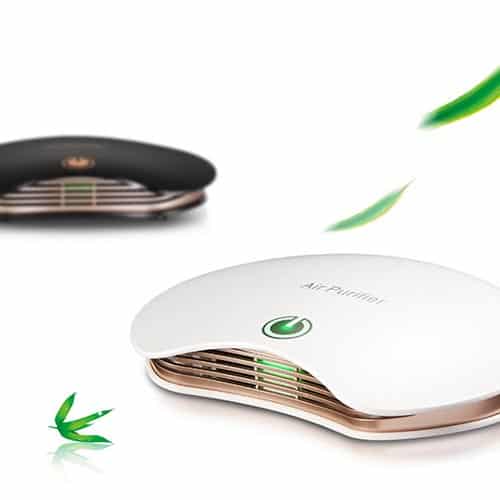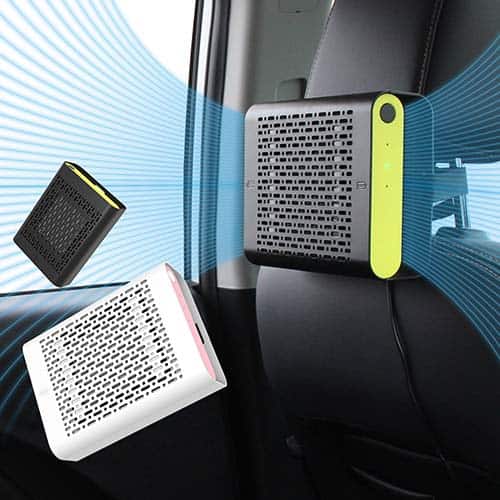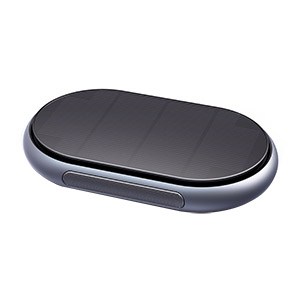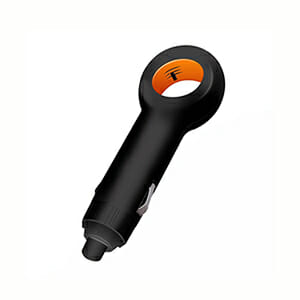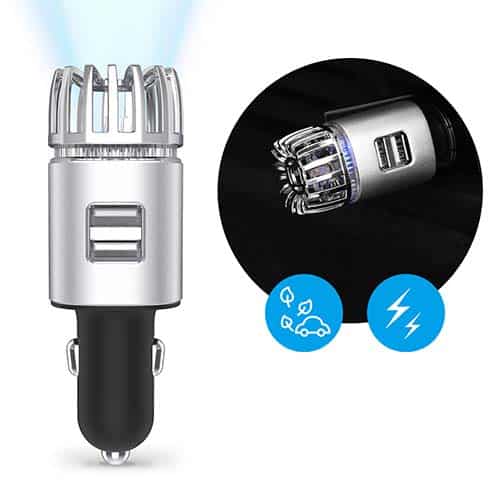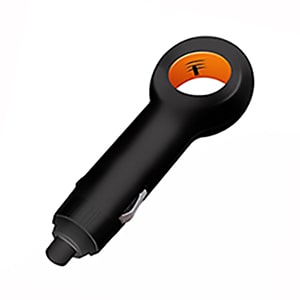Roads and highways are notorious for having elevated levels of air pollution. So, in riding in a car we are in a sense trapped in an environment with poor air quality.
And if you smoke in the car or have pets, the importance of fresh, clean air is obvious.
So, how do you best deal with these issues to breathe safe and clean air?
We will go into some detail to provide you with steps you can take to best solve these issues.
Sources of Air Pollution in a Car
There are many reasons for poor air quality in a vehicle. Some were mentioned above and here is a list of the most common sources of pollution you may encounter.
- Odors
- Cigarette smoke
- Carbon Monoxide and exhaust fumes from other cars
- Carbon Dioxide
- Pet Dander
- Particulate matter like dust, mold, pollen and bacteria
Most of the items in this list are gases (the first four). Gases are difficult to remove with an air purifier since they are incredibly small and require advanced gas filter media. We go into detail in our comprehensive air purifier guide for how to effectively remove them.
The pet dander, dust and pollen are airborne particulates and larger than gases. To remove them you need a HEPA air filter as the solutions for gas removal are not effective. Particulate matter is best captured in a net like the fibers of a HEPA filter. Gases in contrast are often adsorbed into a material like activated carbon.
So, from an air purifier perspective it depends upon what you need the air cleaner to do before you can identify the best solution.
Strategies to Clean the Air
There are 3 main strategies to clean the air in any environment. This applies to a home, the office or in a vehicle.
- Source control – remove the source of the issue. In a car this can be difficult since you don’t have a choice but to drive on the road.
- Ventilation – this is achieved by circulating air from the outside or by rolling down the windows. Again, this can be difficult depending upon the weather conditions or pollution on the roads.
- Air Cleaning – using an air filter to remove the pollutants.
This list is sorted in the order of importance. So, source control is the first choice, followed by ventilation and then air cleaning.
Purpose of Your Car’s Air Filter Cars come with an air filter. What is interesting is that the purpose is the same as the air filter in your air conditioning or furnace heating system. And that is to protect the equipment and not your health.
In most cases this is a low efficiency pleated filter. This means it will filter out the larger particles only which is most important in maintaining the operation of your vehicle.
The same issue exists with your HVAC filter in that the fans are not strong enough to pull air through a higher efficiency filter. So, your car air filter will only remove the biggest pollen or dust particles. And not the finer particles that you breathe into your lungs.
Furthermore, imagine if you wanted to remove fumes and emissions from vehicle exhaust. In other words, the gases we listed above. This issue is even harder since a bank of carbon has more air flow resistance and therefore requires a stronger fan to pull the air through.
We looked at developing a better filter that could be placed in a car however we determined this was not practical since the fans in a car are just not strong enough. The result would be much lower air flow. This would create a strain on the fan as well as poorer performance in the air conditioning.
So, it’s a difficult problem to solve given the limitations. In addition, it takes a good amount of energy to move air through a filter that is effective and there is not a lot of power in a cigarette lighter adaptor.
And this leads us to the current car air purifier solutions.
How Car Air Purifiers Work
For the most part, car air purifiers work on the same principles as a room air purifier although they are much smaller in size. It’s more like a mini or personal air purifier with a limited power source.
Here is a listing of the most common technologies. We will examine each in more detail below.
- Negative ion generator – also referred to as a car air ioniser.
- HEPA filter
- Activated Carbon filter
- Ozone generator
- Air Freshener
Negative Ion Generator
The negative ionizer works by emitting a negative charge into the air. There is no filter to catch the particles. This is simply an electronic device and most often is plugged into a cigarette lighter. This car air ionizer requires little power.
The concept is that negative ions clean the air of particulates by attaching to the dust, pollen or mold spores and then they are more easily attracted to a surface.
However, this does not address the most common issue and that is gas, smoke and odor removal. The only way a negative ioniser could remove any gas is if it creates ozone. This is problematic since ozone is a lung irritant and considered air pollution. We are not meant to breathe in ozone and should avoid it.
HEPA Filter
A HEPA air filter is the best technology to remove airborne particulates and it does so safely. The problem we have seen with HEPA filters in car air purifiers is that they are much too small to be effective and/or are not true HEPA.
As we explain in 5 reasons to buy Oransi air purifiers, the bigger the filter is and the higher efficiency it has the better it will do in cleaning the air. You simply cannot cut corners and make a tiny filter or one with a low efficiency. It won’t be able to filter much.
Recently, Tesla came out with what they call the Biodefense HEPA filtration system in one of their car models. It seems they did the right thing and built a strong enough fan to power the air through a HEPA filter. The gap that we see with this is that HEPA is not effective for gases. And gases are the primary reason people buy a car air purification system. Gases like car fumes will pass right through the HEPA air filter fibers. For something like cigarette smoke removal, the HEPA air filter will remove the smoke particles but not the smoke odors.
Activated Carbon Filter
A filter with activated carbon is good in removing many of the gases associated with smoke removal and car fumes. The problem here is that it requires a good amount (more than a pound in a car) as well as a good air flow. The car air purifiers we have seen do not have strong enough motors or enough carbon to remove the pollutants.
In addition, you simply cannot put a container of active carbon in your car and expect it to clean the air.
Furthermore, carbon is not effective for all gases. You often will want additional gas filter media or a treated carbon to have a more complete solution.
For HEPA and activated carbon to work you need more power and you don’t have that with the cigarette adaptor or enough space in the car for an air cleaner that is effective.
Ozone Generator
An ozone generator works as its name implies and that is to create ozone. While ozone can be very effective in gas removal it is terrible to breathe in. And extremely bad if you have a respiratory issue like asthma, COPD or bronchitis.
As far as I know car air cleaners are not regulated like room air purifiers for ozone.
The only time you would want to use an ozone generator would be in a car when no people are present to remove odors. For example, if you need to remove smoke odors from a car interior, you could use an ozone generator to “shock” the car.
Other than that, you should stay away from ozone.
Air Freshener
An air freshener works by masking odors in a car. It does not remove any odors but rather gives off its own odor so you do not notice the odor you are wanting to avoid.
An air freshener introduces gases into your car. It’s not an ideal solution since you breathe in whatever they give off.
Do Car Air Purifiers Work?
Given what we have described above we have no confidence that a car air purifier will provide the clean air you are looking for.
The problems are real, however the solutions simply are not effective. In my opinion, they are quite gimmicky and if they produce ozone you are introducing pollution into your car. This goes against our philosophy of providing products that are effective and safe. So, this is not a product we have any interest in making or selling.
However, there is one solution we have seen in military use that could be effective but would require an installation in a vehicle. This is like a whole house or commercial air purification system for a car where you have a separate fan and filter bank. To work effectively you would have to give up some space, say in your trunk as well as go through an installation process.
Another solution would be to wear a mask. This will filter out many of the particles however unless you are wearing a respirator with a filter you will likely not be able to filter out the gases. When I am in China and wear a mask, I can still smell the pollution as well as tobacco smoke odors so I know even a N95 mask has limitations.
Conclusion
Poor air quality and pollution in cars is a serious problem. And one that is difficult to address since it requires the removal of both gases and particulates.
The air filters that come installed in cars are not designed to provide a clean air environment for people.
The car air purifiers on the market in our opinion are more gadgets than real solutions and in some cases can introduce pollution into your vehicle.
We will continue to look for a solution that is effective and practical. From experience, there are no shortcuts since moving air and filtering are based on the laws of physics and to do it right you simply cannot snap a small car plug-in device into your cigarette lighter.
At this point, we have not seen anything on the market that we would suggest you purchase. In my humble opinion, current products are a waste of money.

